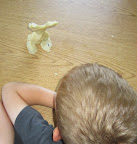Getting to know our students as they get to know themselves
By Peggy Ashbrook
Posted on 2012-09-13
 During the first weeks of school many preschool and kindergarten teachers have their students draw self-portraits as a way of getting to know children’s fine motor skills and developmental age in drawing, as well as teach vocabulary for parts of the body and sense structures. (See the lovely gallery of self portraits from Clipston Primary School in the UK.) Copies of the beginning-of-the-year self-portraits are kept in a portfolio of student work. When students make final self-portraits for the year, they can be used to see the child’s growth in abilities in fine motor skills and in using symbols to convey meaning, such as hearts drawn around a family group.
During the first weeks of school many preschool and kindergarten teachers have their students draw self-portraits as a way of getting to know children’s fine motor skills and developmental age in drawing, as well as teach vocabulary for parts of the body and sense structures. (See the lovely gallery of self portraits from Clipston Primary School in the UK.) Copies of the beginning-of-the-year self-portraits are kept in a portfolio of student work. When students make final self-portraits for the year, they can be used to see the child’s growth in abilities in fine motor skills and in using symbols to convey meaning, such as hearts drawn around a family group.
 Drawing a self-portrait is just one of many activities that can be part of an investigation into the human body. Children may have stories to tell about visits to the doctor, the birth of siblings, learning to use the toilet, losing a tooth, and developing physical abilities such as jumping or riding a bicycle. The Illinois Projects in Practice article, “Helping Children Sketch and Draw from Observation,” lists the many ways drawing and telling stories relate to Illinois Early Learning benchmarks throughout the curriculum.
Drawing a self-portrait is just one of many activities that can be part of an investigation into the human body. Children may have stories to tell about visits to the doctor, the birth of siblings, learning to use the toilet, losing a tooth, and developing physical abilities such as jumping or riding a bicycle. The Illinois Projects in Practice article, “Helping Children Sketch and Draw from Observation,” lists the many ways drawing and telling stories relate to Illinois Early Learning benchmarks throughout the curriculum.

As children get to know the parts of their body, they can make comparisons with the body structure of other animals. They begin to understand that animals can be grouped—worms have no legs and a soft body, insects have six legs and a hard exoskeleton as contrasted with our four limbs, soft exterior and hard skeleton. Using playdough to make models is one way to document observations. If the children find an earthworm or a cricket, contain it for an hour so children can observe it and record their observations by drawing, modeling with playdough, clay, or pipe cleaners (aka “fuzzy sticks”).

 Children like to make models of their family pets. When children find their larger playdough models won’t stand up, ask them, “What helps you to stand?”, beginning a discussion about bones. Pipe cleaners or sticks representing the skeleton can be added to the models to make them able to stand. In the September 2012 issue of Science & Children I write about looking at bones and making models to learn about our bodies. Children are often very interested in bones—read about Jake in Scotland who began collecting bones when he was 6 years old with the support of his father. To observe animals with and without bones, visit the Smithsonian National Zoological Park’s OctopusCam and view the giant Pacific octopus–and its human visitors as they view it in the Invertebrate Exhibit.
Children like to make models of their family pets. When children find their larger playdough models won’t stand up, ask them, “What helps you to stand?”, beginning a discussion about bones. Pipe cleaners or sticks representing the skeleton can be added to the models to make them able to stand. In the September 2012 issue of Science & Children I write about looking at bones and making models to learn about our bodies. Children are often very interested in bones—read about Jake in Scotland who began collecting bones when he was 6 years old with the support of his father. To observe animals with and without bones, visit the Smithsonian National Zoological Park’s OctopusCam and view the giant Pacific octopus–and its human visitors as they view it in the Invertebrate Exhibit.Disclaimer: The views expressed in this blog post are those of the author(s) and do not necessarily reflect the official position of the National Science Teaching Association (NSTA).


